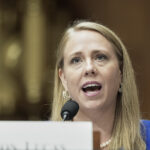On June 12, Reliance Group Holdings (RGH), the parent company of Reliance Insurance Company (RIC), one of America’s oldest insurers, which traces its roots back to 1817, filed for bankruptcy protection in the Southern District of New York. The petition listed total assets of $12.598 billion and total liabilities of $12.877 billion.
The parent’s fate is now in the hands of the Trustee in Bankruptcy, but the 184-year-old Pennsylvania-based company’s future will be decided by Diane Koken, the State’s Insurance Commissioner.
Financier Saul Steinberg and his family controlled RGH, which owns 100 percent of Reliance Financial Services Corp. (RFS). It in turn owns RIC and nine other insurance subsidiaries.
All of them are included in the bankruptcy proceedings, but only RIC and its related companies are under administration by the Pennsylvania Insurance Department (PID), which obtained an “Order of Rehabilitation” for RIC from the Commonwealth Court on May 29.
RIC is not yet in liquidation. “We’re mainly interested in protecting the assets so that policyholders can be protected as well,” said Rosanne Placey, PID press secretary.
Steinberg resigned in May, but he’s not forgotten. He acquired a controlling stake in RGH in 1968 through a leveraged buyout. For years the high-profile corporate raider used it as the base of a financial empire that anchored his takeover attempts of Chemical Bank in 1969, and his raids on Walt Disney, Quaker Oats and other companies in the 1980s.
Unfortunately the indiscriminate issuance of debt instruments and the mounting losses at RIC finally caught up with him. The first signs of real trouble emerged with the collapse of the Unicover pool in 1999. Reliance was heavily involved in issuing workers’ compensation policies at extremely low rates, and when the pool was overwhelmed by huge losses, RIC’s reserves began to vanish.
As recently as 1998, the company was still profitable, earning $326 million on gross revenues of $3.4 billion. Steinberg’s aggressive acquisition strategy and quest for ever higher dividend payments, however, left RIC vulnerable in the cutthroat competition for market share, which led to a deterioration in underwriting standards that eventually resulted in the unsustainable losses.
As it became more apparent that RGH and its subsidiaries were in deep financial trouble, Steinberg sought to sell the company. Leucadia National offered to buy it in May 2000 for $295 million in shares of stock, but withdrew the offer in July, as the financial condition worsened. A similar agreement to sell RIC’s European operations to London’s Candover Investments fell apart in September.
A.M. Best began to downgrade RIC’s claims paying ability from “A-” in June to “C” by August. It effectively stopped writing new or renewal business in all its lines last June, and began looking for ways to downsize.
As a result, insurance regulators sought more information and assurances that RIC entities could pay claims.
In August, RIC entered into an agreement with the PID, agreeing not to pay dividends or make other disbursements without its approval. After having twice strengthened its claims reserves in 2000, a September filing showed a statutory surplus of $624 million.
This surplus began to evaporate, however, as claims increased, due in part to potential claimants accelerating their demands as RIC’s shaky financial condition became more widely known.
At the end of January 2001, RIC agreed to regulatory supervision by the PID. A.M. Best downgraded its claims paying ability to “E” to reflect this.
The bankruptcy filing revealed that RGH was unable to complete a full audit of its accounts for 2000, but it estimated that underwriting losses at RIC were between $1.9 and $2.2 billion, with an additional loss estimate for the first quarter of 2001 between $110 and $150 million.
While investment income and the sale of various properties may mitigate the net exposure, bankruptcy reorganization became mandatory. RGH wrote off its entire investment in RIC last month, as it had indicated it planned to do, and sat down with its creditors.
The May 29th court order had already put RIC under the full control of the PID, and one of Commissioner Koken’s first acts was to file suit against RGH and RFS in an attempt to recover an estimated $95 million allegedly wrongly transferred to them from RIC. She also sought an order blocking any cash disbursements from RGH, alleging that the money should go to RIC. RGH has denied the claims.
Most of RGH’s major creditors approved the reorganization plan set out in the bankruptcy filing, except legendary financier Carl Icahn, who controls an estimated $69 million in RGH debt through his investment company High River LP.
Under the plan, the banks—which are owed around $261 million in secured debt by RFS—would receive new notes totaling around $238 million and 86 percent of the voting rights for the operation. It would in theory continue to be RIC’s parent company.
RGH also owes interest and principle on about $463 million worth of bonds to various creditors, including Icahn. They would receive new notes, payable over 10 years, and would take over the company. All other shares would be cancelled. Icahn has previously indicated that he would oppose any restructuring plan that did not protect bondholders, and has yet to comment, but he isn’t expected to go along with it.
The PID has engaged independent consultants to review RIC’s financial condition. “In the coming weeks and months, we will use that review to develop the factual information we need to make a reasoned determination of whether to proceed with rehabilitation, or to move to liquidation,” Koken stated. Placey indicated that the Department at first expected this would take around six months, “now we’re sure it will take at least six months,” she affirmed. The PID has so far taken no position on the bankruptcy reorganization.
Its main concern is to assure that there will be sufficient resources to satisfy the claims of policyholders; if so, RIC might actually be rehabilitated and survive in a truncated form.
If not, then liquidation appears to be the only alternative, as funds would be required from other insurers who are pledged to participate in paying the claims only of insolvent companies to Pennsylvania residents or property holders through guarantee associations, established along insurance lines. Their burden is proportional to the amount of insurance each association member writes in Pennsylvania, so that large insurers like Chubb and AIG would pay more than smaller companies.
Topics Claims Pennsylvania
Was this article valuable?
Here are more articles you may enjoy.


 Grand Jury Declines to Indict Man in Fatal Shooting at Kentucky State University
Grand Jury Declines to Indict Man in Fatal Shooting at Kentucky State University  Louvre Tightens Security After $102M Jewel Heist, Installs Bars on Infamous Window
Louvre Tightens Security After $102M Jewel Heist, Installs Bars on Infamous Window  Head of EEOC Urges White Men to Report Discrimination
Head of EEOC Urges White Men to Report Discrimination  US P/C Posts $35B YTD Underwriting Gain; By-Line Premium Growth Revealed
US P/C Posts $35B YTD Underwriting Gain; By-Line Premium Growth Revealed 


